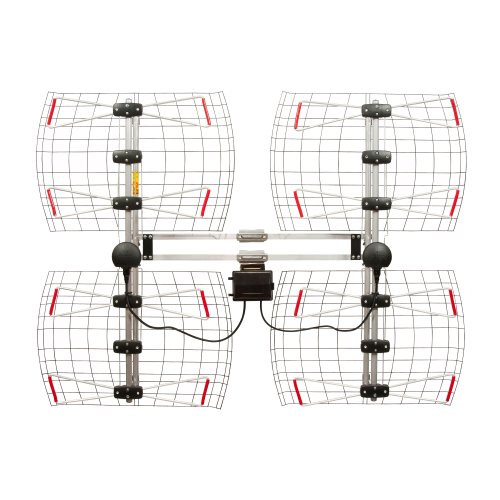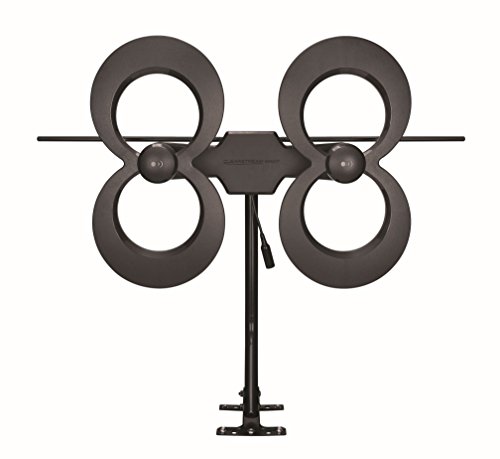With cable and satellite TV subscriptions getting ridiculously expensive, more and more homes are ditching pricey pay TV and choosing free, over-the-air broadcasts. Digital TV typically provides between 20 and 60 channels depending on where you live, and can save you at least $1,000 a year, based on a typical pay TV subscription.
So, cut that cable, ditch that dish, and join the 14 percent (and growing) of American households that are free from monthly bills for TV service.
Putting up an antenna is easy, but before you buy one you’ll need to figure out what channels are available where you live, how strong the signals are likely to be, and what direction they’re coming from. See TechHive’s guide to choosing an antenna to figure all that out.
As a rule of thumb, indoor antennas are suitable for areas with strong or very strong signals, the attic/outdoor antennas work in areas of medium signal strength, and the larger outdoor antennas in areas of weak signals.
Once you’ve determined your needs, this article will help with your antenna purchase.
Updated February 12, 2019 to add a video explaining how to determine which free over-the-air TV channels you can receive where you live (see below).
Best indoor TV antenna
 Winegard FlatWave Amped (model FL-5500A)
Winegard FlatWave Amped (model FL-5500A)Winegard’s FlatWave Amped delivers great performance for an indoor antenna. It’s small, lightweight, and should work well in areas that enjoy strong local TV reception.
This antenna impressed us with its ability to pull in more broadcast channels than the competition. Further, those it did receive were a little stronger than from our runner-up which should make for happier TV viewing. (Read our full review.)
Runner-up
 Clearstream Flex
Clearstream FlexThe Clearstream Flex is one of the best performing indoor TV antennas in its class, but don’t try to push its range too much as performance falls off as signals get weaker.
The Antennas Direct Clearstream Flex is a large, flexible antenna for mounting inside your house against a window or on a wall. It comes supplied with an inline amplifier that gave a good boost to signal levels in our tests. It did well on both VHF-High and UHF reception—the broadcast bands that include the vast majority of large stations in the U.S. (Read our full review.)
Best roof-mount TV Antenna
 Antennas Direct DB8e
Antennas Direct DB8eThe Antennas Direct DB8e is a large outdoor antenna for reception of medium to very weak TV signals. In our tests, it was very good pulling in distant stations with minimal interference.
The Antennas Direct DB8e’s reception is just as impressive as its looks. This is a large, heavy antenna cleverly designed to receive weak signals with two antenna arrays, or in areas of better reception to point to towers in different directions. (See our full review.)
Runner-up
 Antennas Direct 91XG
Antennas Direct 91XGThe roof-mount Antennas Direct 91XG does a great job of pulling in weak TV signals.
The Antennas Direct 91XG is a classic antenna design that has worked well for years. This antenna is quite directional and good at rejecting interference from the sides while picking out weak signals from the noise. It narrowly missed out on the top spot and would also be an excellent choice for people dealing with long-distance reception. (See our full review.)
Best attic/outdoor TV antenna
 Winegard Elite 7550
Winegard Elite 7550The Winegard Elite 7550 is a sensitive TV antenna suitable for areas with strong to medium strength signals.
The Winegard Elite 7550 immediately impressed with its ability to pick up more broadcast channels than the competition at higher signal levels. It has a built-in amplifier and performed well on both VHF-High and UHF broadcast bands. Because of its size you’ll want this one in the attic or outside of your house. (See our full review.)
Runner-up
 Clearstream 4 Max
Clearstream 4 MaxThe Clearstream 4 Max is an excellent choice for areas with strong to medium strength signals and with multiple TV transmitters in different locations. It’s well made, easy to assemble and supplied with all the required mounting hardware.
The Clearstream 4 Max is a little larger than our top-ranked choice and wasn’t quite as good at pulling in stations but it’s still a solid antenna. Its unique double figure-eight design is sure to look distinctive and it can receive signals from different directions, which is useful if you live in an area with stations in multiple places. (See our full review.)
How we tested
TechHive tests TV antennas in one or two locations. Our main testing location is 30 miles North East of San Francisco in an area sandwiched between hills that make reception of signals from San Francisco and Sacramento difficult. It’s a good spot to test antennas because many channels are weak. Antennas are mounted 25 feet in the air on a rotatable mast and tests are run several times.
We use a set-top box to scan for channels and record the number of RF channels received by each antenna and their strength. Each RF channel carries a number of digital stations, but the number is different per channel and can change, so digital stations received isn’t as useful a measurement. We scan several times and adjust the direction of the antenna on some rescans.
Our picks are the antennas that receive the largest number of stations with the highest signal level in both the UHF (channels 14 through 51) and VHF-High (channels 7 through 13) bands, which are the primary TV broadcast bands.






Recent Comments